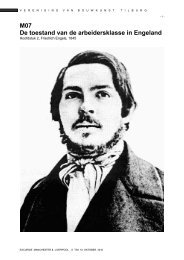Chandigarh Ahmedabad – Le Corbusier - Vereniging van ...
Chandigarh Ahmedabad – Le Corbusier - Vereniging van ...
Chandigarh Ahmedabad – Le Corbusier - Vereniging van ...
You also want an ePaper? Increase the reach of your titles
YUMPU automatically turns print PDFs into web optimized ePapers that Google loves.
the Capitol Complex buildings and parks and its precise situation in the landscape. The second is the 'Town<br />
Hall', placed in the City Centre.<br />
What are the other workings? The one which answers to the possibilities which are listed in the paragraph (ii)<br />
edition, festivals, etc. They ask for precise locations on the ground of the city. One part is already realised in<br />
location and in buildings: the university and colleges and schools with proper zoning. (The principle being that<br />
former are located in the green on the limit of the city and the latter located in the internal NE/SW belt of<br />
green).<br />
A small reserve of ground was given for an undefined industry east of the city near to the station. Very little of<br />
this ground remains today available.<br />
IV: Constituent elements occupying the ground of the city<br />
1. The Sectors<br />
2. The 7Vs, which are 8<br />
3. The resulting geography: concentration and dissemination (in the city and out of the city)<br />
4. Indispensable fact, unacceptable facts (their biology)<br />
5. Statute of the Land<br />
6. Augmentation (appreciation) in the value of land by clever methods.<br />
(a) The key of modern urbanism is 'the Sector' which is a container of family life (24 solar hours: night and<br />
day). The contents being from 5,000 to 20,000 inhabitants (approx.). <strong>Chandigarh</strong> has 30 sectors: each sector<br />
has its maintenance organisations, the food provisions, the schools (kindergarten and primary) the necessary<br />
artisans (repairs, etc) the daily leisure (movies etc) all traversing in the middle of each sector -- it is the V-4<br />
(see below). The V-4 given the horizontal connection between the contiguous sectors. The sectors are also<br />
specially devoted to all what concerned family life (Man, Woman and Child), day and night. The sector is<br />
surrounded by high-speed roads with bus stops every 430 meters and giving the eight entrances in this social<br />
group. The fundamental principle of the sector is that never a door will open on the surrounding V-3s:<br />
precisely the four surrounding V-3s must be separated from the sector by a blind wall all along. In<br />
consequence, the sector will never receive transit buses or cars. If there were today any actual organisations<br />
which have broken this rule, it should be set right. However, the v-4 can accept the through passage of cars<br />
and buses but only at low speed. Each sector will have a green properly oriented in the direction of the<br />
mountain, constituting a band vertically connecting a series of sectors. In these bands will be installed the<br />
diverse schools and the sports fields.<br />
(b) The 7-Vs which are 8 It is the rule which was established before ten years at the demand of the UNESCO<br />
to try to constitute an eventual acceptable proposition of urbanism for general world application. The resume<br />
of these 7-Vs for this present report (which as to prepare 'The <strong>Chandigarh</strong> Statute of the Land) is the<br />
following: Seven kinds of ways (which now are eight) can bring in the modern life the solution of contacts<br />
between different organisms which constitute the containers of the activity of the machinist age. The V-1 is the<br />
road which is going through the continents, traversing rural areas and cities. The V-2 take immediately the<br />
succession of V-1 at the beginning of the city. Other V-2s can be the tracings of intentional municipal will of<br />
greatness and usefulness together. The V-3s are a new kind of roads devoted exclusively to vehicular traffic<br />
(especially fast traffic). These ways must be interrupted the least. They are surrounding the sectors as<br />
explained above. The V-4 is the right place of the 24 hours life of a sector. It is a linear event and particularly<br />
in <strong>Chandigarh</strong>. It should be situated on the shadow side (which is the SW side) The V-5s are roads which<br />
assure the internal distribution of traffic inside a sector. The V-6s have to give access to the doors of the<br />
dwellings. V-5 and V-6 must never receive a transit traffic (bicycle, cars and buses). The V-7 is situated in the<br />
green ribbon going SW to NE in the direction of the hills. The V-7 gives the vertical contact between the<br />
sectors and crosses the V-2 South and two other horizontal V-2s. We can affirm soon that the V-7 (for<br />
pedestrians only) has to V-2 and V-3 with passeralles (footbridges) which can be made now or later<br />
depending on the situation (conjecture). These bridges must immediately be drawn on the urbanist plans from<br />
now on. The traffic of the bicycles, lambrettas, vespas, auto-cycles will have to take a separate way along the<br />
green ribbon with the intention to realise the function of the bicycles in a modern city. These seven ways have<br />
been named after the creation of V-7 because of the recent appearance of the cycle with the two wheels all<br />
the world over. The two-wheeled vehicles have never to use the same way as the four-wheels and the threewheels,<br />
<strong>Chandigarh</strong> is the first application of this new system of roads -- one must add that for the creation of<br />
urbanism, drawings, discussions, meetings, this designation of V-1, V-2, V-3 etc has brought an extraordinary<br />
clarity.<br />
9 / 27






